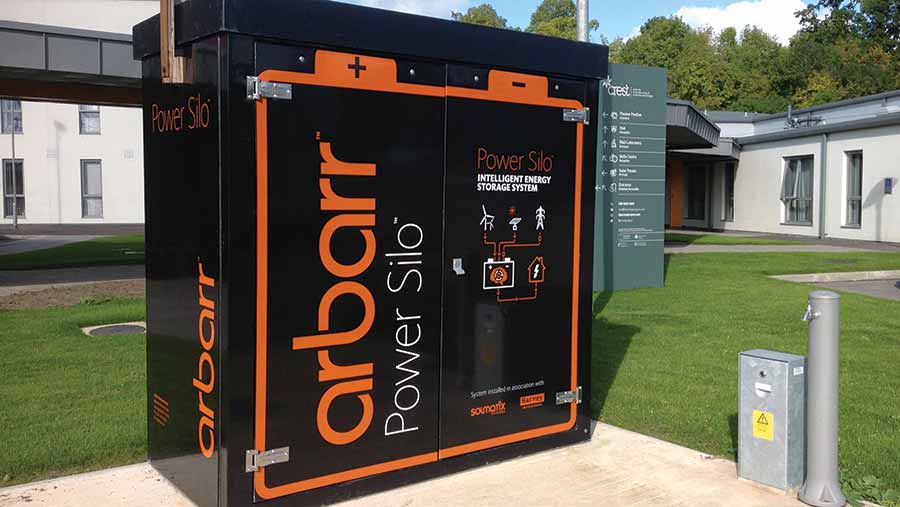Lower costs raise battery storage potential

Dramatic reductions in the cost of battery technology in recent years – largely due to advances in electric car production – could soon make the technology viable for many farm businesses.
This is according to research carried out by John Harrison, senior lecturer at South West College (SWC) in Northern Ireland.
SWC has just installed a 45kW robotic tracking solar array and battery storage system at its Centre for Renewable Energy and Sustainable Technologies (CREST) building in Enniskillen.
The 18kW Arbarr Electronics lithium-ion “power silo” can supply up to 40kWh of electricity and will be used to investigate how energy loads can be matched to generation from the solar array.
See also: Battery back up: costly but worth it for some farm renewables projects
Tweaking energy use to optimise the balance between electricity supply and demand is key to the viability of farm-based battery storage, says Dr Harrison.
Material change
Advances in battery technology will dramatically improve performance and uptake over the next decade, allowing “greater penetration of intermittent renewable energy”, according to BP’s Technology Outlook report.
Next-generation batteries, such as rechargeable lithium sulphur, could increase energy storage capacity three-fold by 2025, from 150Wh/kg to 450Wh/kg, allowing wider uptake in vehicles and for electricity grid applications, it says.
But it acknowledges electric and fuel-cell vehicles still need significant technological advances before becoming cost-competitive with internal combustion engines.
The report also predicts biofuel costs will fall, especially second-generation biofuels made from grasses, wastes and other non-edible agricultural matter.
It says that a three- to four-fold increase in annual biomass energy production is possible by 2050, putting its output alongside that of today’s oil sector, but this will require increased crop productivity and improvements to biofuel production processes.
“It’s all about designing the whole system correctly by considering where energy is going across the business, the type of loads involved and how this relates to the generation profile of renewable technologies.
“Then you can match the battery to energy demand.”
About half of UK energy use is for space or water heating and it is generally cheaper to store thermal energy (for example, in the form of hot water) than it is to keep electricity in a battery, he says.
Getting cheaper
However, battery storage is evolving quickly – from both technology and cost perspectives – in a similar way to that seen in solar PV, says Dr Harrison.
Typical battery costs (excluding installation) are falling by about 30% a year and stand at about £500/kWh, although systems costing much less are being developed, he says.
As with solar, there are other costs to consider and quotes can vary widely, he warns.
The battery itself accounts for about half the total cost of a storage system, with inverters, other electrical equipment and installation making up the remainder.
Battery storage is not yet cost-competitive with a good grid connection.
However, Dr Harrison believes this will change and that it may already be worth considering for off-grid businesses reliant on diesel generators or those with enterprises susceptible to power cuts and requiring reliable back-up.
It is possible to be entirely off-grid with battery systems connected to solar, as PV arrays can be shut down when the battery is full.
Some wind turbines can also be run off-grid; others need a connection even where batteries are used, says Dr Harrison.
Batteries – points to consider
- Size: battery storage can be incorporated into new renewable energy systems or fitted retrospectively – the limiting factor is the size of the inverter, which determines power rating. Batteries are modular, allowing storage capacity to be expanded over time.
- Lifespan: depends on how hard the battery is worked – how many deep discharge/recharge cycles it goes through. Most batteries should last 3,000-5,000 cycles at 80% discharge (from full down to 20% capacity), although this varies and capacity declines with age. Many warranties and guarantees last 8-10 years.
- Performance: depends on age of the battery, charging/discharging regimes and temperature. Extreme hot or cold reduces battery capacity so should be avoided. Some large-scale systems are temperature-controlled, but this is not yet available on smaller systems. Most systems have some form of power output monitoring based on the inverter.
- Planning and insurance: most systems are relatively small, so planning is not an issue unless a new building is required. Check if extra insurance cover is required.
- DIY system? Home-made battery storage systems using conventional lead acid batteries can work and cost less upfront. But lead acid typically cycles only from 30-80% capacity and is not suited to being fully discharged, which significantly shortens battery life. Having only around half of the rated capacity available means twice as many lead acid batteries will be needed, compared with lithium-based batteries.
